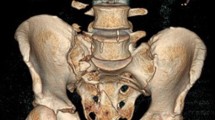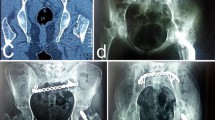Abstract
Little information is provided in the literature describing an efficient reduction technique for pelvic ring disruption. The aim of this study is to assess the use of the transcondylar traction as a closed reduction technique for vertically unstable fracture-dislocations of the sacro-iliac joint. Twenty-four pelvic ring disruptions were treated with attempted closed reduction followed by percutaneous screw fixation. Transcondylar traction was used as a closed reduction technique. Closed reduction to within 1 cm of residual displacement was obtained in all cases. No incidence of infection, digestive, cutaneous, or vascular complications occurred. We observed secondary displacement in three patients. Correction of the vertical displacement is better achieved when performed within 8 days after the trauma. Two posterior screws and a complementary anterior fixation is typically required to avoid further displacement in case of sacral fractures. However, an open approach should be preferred in both cases of crescent iliac fracture-sacroiliac dislocation and transforaminal fracture associated with peripheral neurological deficit. A vertical sacral fracture should make the surgeon more wary of fixation failure and loss of reduction.
Résumé
Introduction: peu d’informations sont données dans la littérature sur les techniques de réduction des ruptures de l’anneau pelvien. Le but de cette étude est d’évaluer l’utilisation d’une traction transfémorale pour les fractures-luxations instables de l’articulation sacro-illiaque. Matériel et méthode: 24 ruptures de l’anneau pelvien ont été réduites par traction transcondylienne puis synthésées par vissage percutanée. Résultat : une réduction a été obtenue avec un déplacement résiduel maximal de 1 cm dans tous les cas. Il n’y a pas eu de problème d’infection, de complication digestive, cutanée ou vasculaire. Nous avons observé trois déplacements secondaires. Discussion: la correction des fractures luxation verticales donne un meilleur résultat si elle est réalisée avant huit jours. Deux vis postérieure et une fixation antérieure complémentaire sont typiquement nécessaires pour éviter des déplacements secondaires, dans les cas de fractures sacré. Cependant un abord chirurgical peut être préféré dans certains cast associant une disjonction sacro iliaque associée à une fracture iliaque ou en cas de fracture sacrée transforaminale associée à des troubles neurologiques. Une fracture sacrée verticale est à haut risque d’échec de fixation et de perte de réduction.





Similar content being viewed by others
References
Borrelli J Jr, Koval KJ, Helfet DL (1996) The crescent fracture: a posterior fracture dislocation of the sacroiliac joint. J Orthop Trauma 10(3):165–170
Griffin DR, Starr AJ, Reinert CM, Jones AL, Whitlock S (2003) Vertically unstable pelvic fractures fixed with percutaneous iliosacral screws: does posterior injury pattern predict fixation failure? J Orthop Trauma 17(6):399–405
Henderson RC (1989) The long-term results of nonoperatively treated major pelvic disruptions. J Orthop Trauma 3(1):41–47
Huittinen VM, Slatis P (1972) Fractures of the pelvis. Trauma mechanism, types of injury and principles of treatment. Acta Chir Scand 138:563–569
Letournel E (1981) Surgical fixation of displaced pelvic fractures and dislocations of the symphysis pubis (excluding acetabular fractures). Rev Chir Orthop 67:771–782
Majeed SA (1989) Grading the outcome of pelvic fractures. J Bone Joint Surg Br 71:304–306
Matta JM, Tornetta P III (1996) Internal fixation of unstable pelvic ring injuries. Clin Orthop 329:129–140
Mosheiff R, Khoury A, Weil Y, Liebergall M (2004) First-generation computerised fluoroscopic navigation in percutaneous pelvis surgery. J Orthop Trauma 18(2):106–111
Nepola JV, Trenhaile SW, Miranda MA, Butterfield SL, Fredericks DC, Riemer BL (1999) Vertical shear injuries: is there a relationship between residual displacement and functional outcome? J Trauma 46(6):1024–1029; 1029–1030
Olson SA, Pollak AN (1996) Assessment of pelvic ring stability after injury. Indications for surgical stabilization. Clin Orthop 329:15–27
Reilly MC, Zinar DM, Matta JM (1996) Neurologic injuries in pelvic ring fractures. Clin Orthop 329:28–36
Routt ML Jr, Kregor PI, Simonian PT, Mayo KA (1995) Early results of percutaneous iliosacral screws placed with the patient in the supine position. J Orthop Trauma 9(3):207–214
Routt ML Jr, Meier M, Kregor P (1993) Percutaneous iliosacral screws with the patient supine technique. Operative Tech Orthop 3:35–45
Routt ML, Simonian PT (1996) Closed reduction and percutaneous skeletal fixation of sacral fractures. Clin Orthop 329:121–128
Routt ML, Simonian PT, Agnew SG, Mann FA (1996) Radiographic recognition of the sacral alar slope for optimal placement of iliosacral screws: a cadaveric and clinical study. J Orthop Trauma 10:171–177
Routt ML Jr, Simonian PT, Ballmer F (1995) A rational approach to pelvic trauma. Resuscitation and early definitive stabilization. Clin Orthop 318:61–74
Routt ML Jr, Simonian PT, Inaba J (1997) Iliosacral screw complications. Operative Tech Orthop 7:206–220
Routt ML Jr, Simonian PT, Mills WJ (1997) Iliosacral screw fixation: early complications of the percutaneous technique. J Orthop Trauma 11(8):584–589
Starr AJ, Walter JC, Harris RW, Reinert CM, Jones AL (2002) Percutaneous screw fixation of fractures of the iliac wing and fracture-dislocations of the sacro-iliac joint (OTA Types 61-B2.2 and 61-B2.3, or Young-Burgess “lateral compression type II” pelvic fractures). J Orthop Trauma 16(2):116–123
Templeman D, Goulet J, Duwelius PJ, Olson S, Davidson M (1996) Internal fixation of displaced fractures of the sacrum. Clin Orthop 329:180–185
Tonetti J, Carrat L, Lavallee S, Pittet L, Merloz P, Chirossel JP (1998) Percutaneous iliosacral screw placement using image guided techniques. Clin Orthop 50:103
Yinger K, Scalise J, Olson SA, Bay BK, Finkemeier CG (2003) Biomechanical comparison of posterior pelvic ring fixation. J Orthop Trauma 17(7):481–487, Aug
Author information
Authors and Affiliations
Corresponding author
Rights and permissions
About this article
Cite this article
Thaunat, M., Laude, F., Paillard, P. et al. Transcondylar traction as a closed reduction technique in vertically unstable pelvic ring disruption. International Orthopaedics (SICO 32, 7–12 (2008). https://doi.org/10.1007/s00264-006-0283-8
Received:
Accepted:
Published:
Issue Date:
DOI: https://doi.org/10.1007/s00264-006-0283-8




